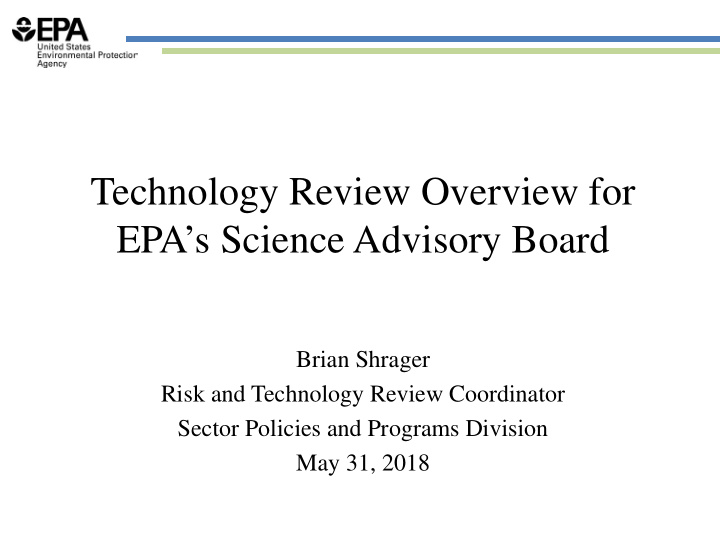



Technology Review Overview for EPA’s Science Advisory Board Brian Shrager Risk and Technology Review Coordinator Sector Policies and Programs Division May 31, 2018
CAA Section 112 Rulemaking 10 Years 12 Months (Staggered Schedule) EPA published a list of Congress identified a Promulgate list of air toxics (or source categories that NESHAPs HAP) to regulate emit these air toxics 8 Years Every 8 Years Residual Risk and Technology Review Technology Review 2
Technology Review Overview ► Clean Air Act Section 112(d)(6) states: The Administrator shall review, and revise as necessary (taking into account developments in practices, processes and control technologies), emissions standards promulgated under this section ► In practice, EPA evaluates the performance of demonstrated methods of reducing hazardous air pollutant emissions and determines whether existing standards should be strengthened ► The technology review is conducted for all emission points subject to MACT standards 3
Developments in Practices, Processes and Control Technologies ► “End-of-pipe” controls, process changes, raw material changes or other operational changes being used in the industry that were not considered during development of original standard ► Demonstrated improvements in control measures that serve as the basis of the current MACT standards ► Changes in control measures considered but not adopted as basis of current standard. ► May include changes in performance, cost, commercial availability and/or feasibility 4
Information Sources ► Information gathered for original rulemaking ► Information Collection Requests and site visits ► EPA’s RACT/BACT/LAER Clearinghouse: http://cfpub.epa.gov/rblc/ ► Trade Associations ► Other recent regulations for similar categories ► State and local regulations 5
Technology Review Analyses ► Evaluate environmental performance of demonstrated control options ► Evaluate feasibility across source category ► Evaluate costs and cost-effectiveness of demonstrated control options ► Evaluate economics and secondary impacts (emissions increases from power needed to run controls, solid waste impacts and other impacts) 6
Sources of Cost Information ► EPA Air Pollution Control Cost Manual ► EPA Clean Air Technology Center Website ► Information Collection Requests ► Previous EPA rulemakings ► Trade Journals 7
Other Considerations ► The technology review is part of a notice and comment rulemaking, where EPA develops a proposal considering available information and stakeholder input, publishes the proposal in the Federal Register and finalizes the rule after consideration of comments received on the proposal ► We solicit feedback on all aspects of the technology review, including costs, performance and feasibility of control methods ► We consider and respond to all public comment as part of the decision-making process for the final rule 8
For questions, contact: Brian Shrager shrager.brian@epa.gov (919) 541-7689 9
Recommend
More recommend